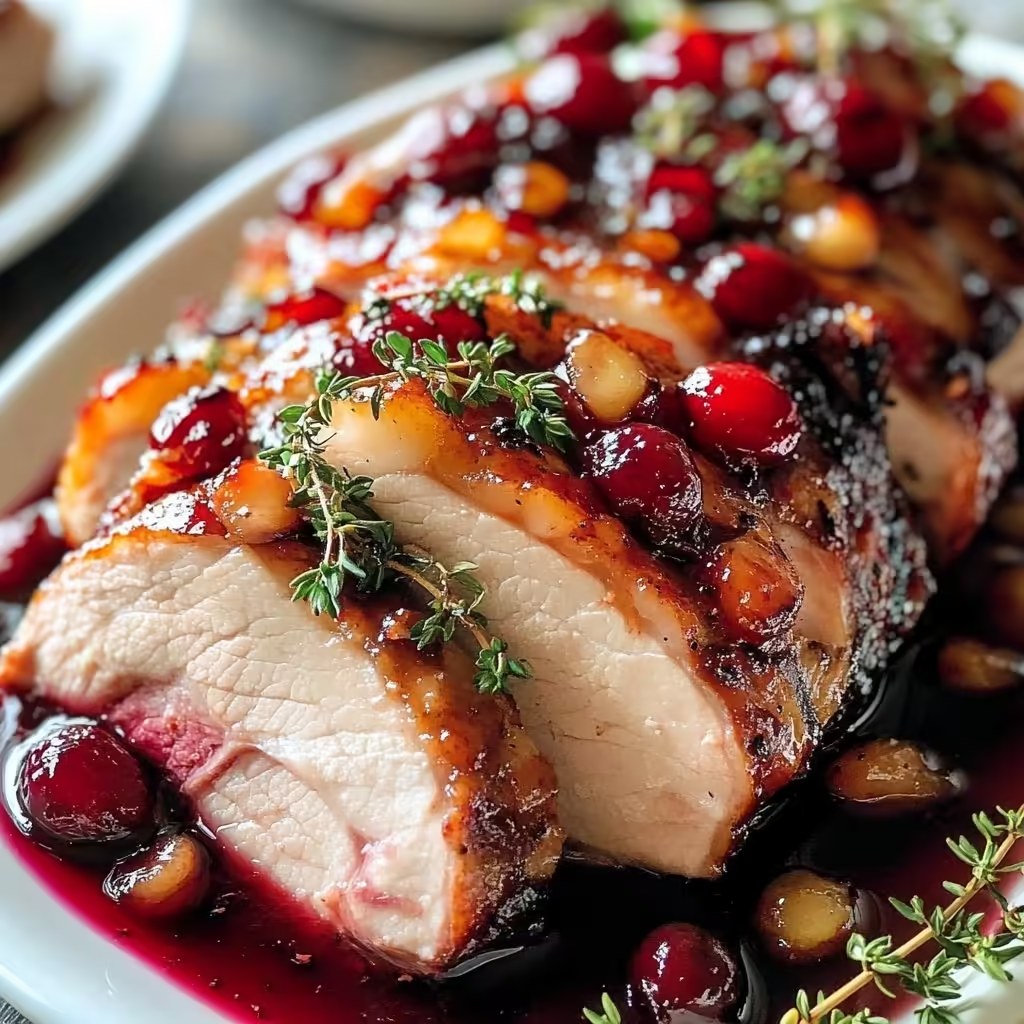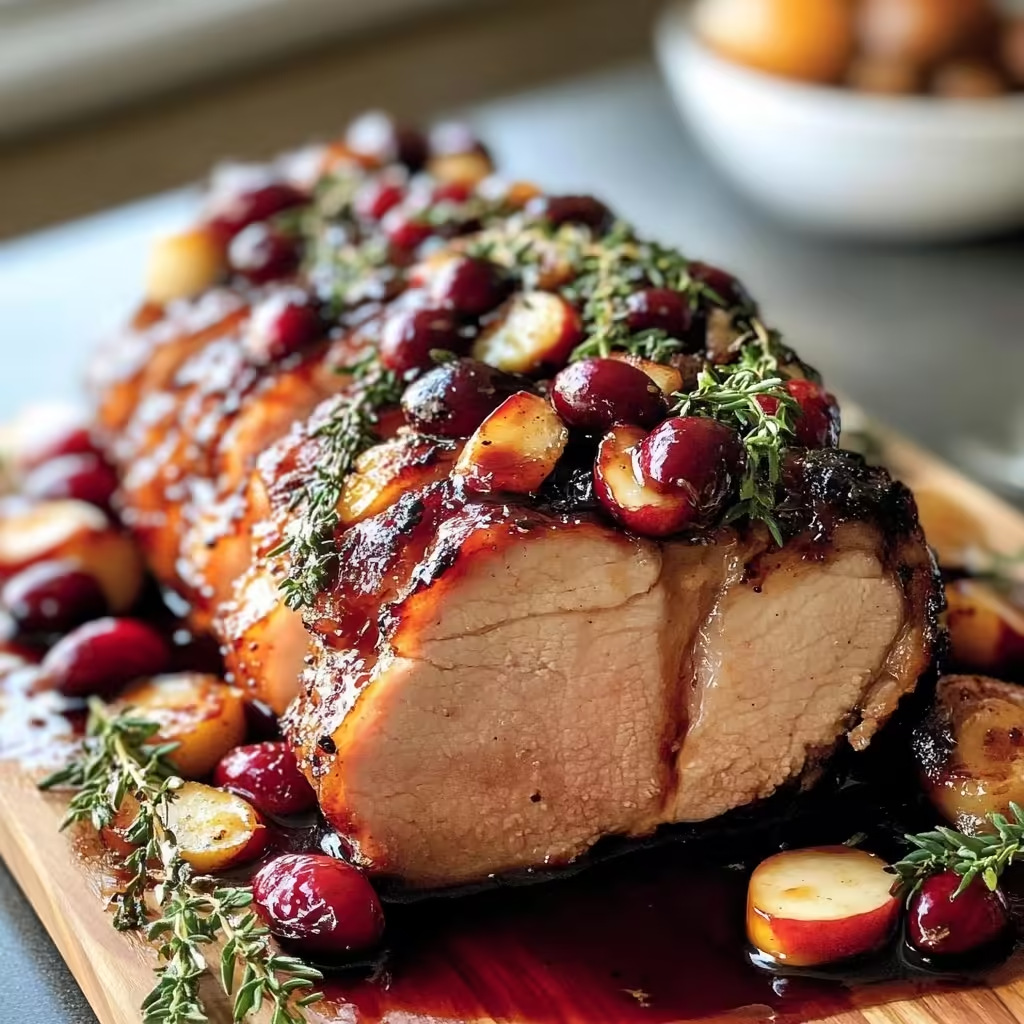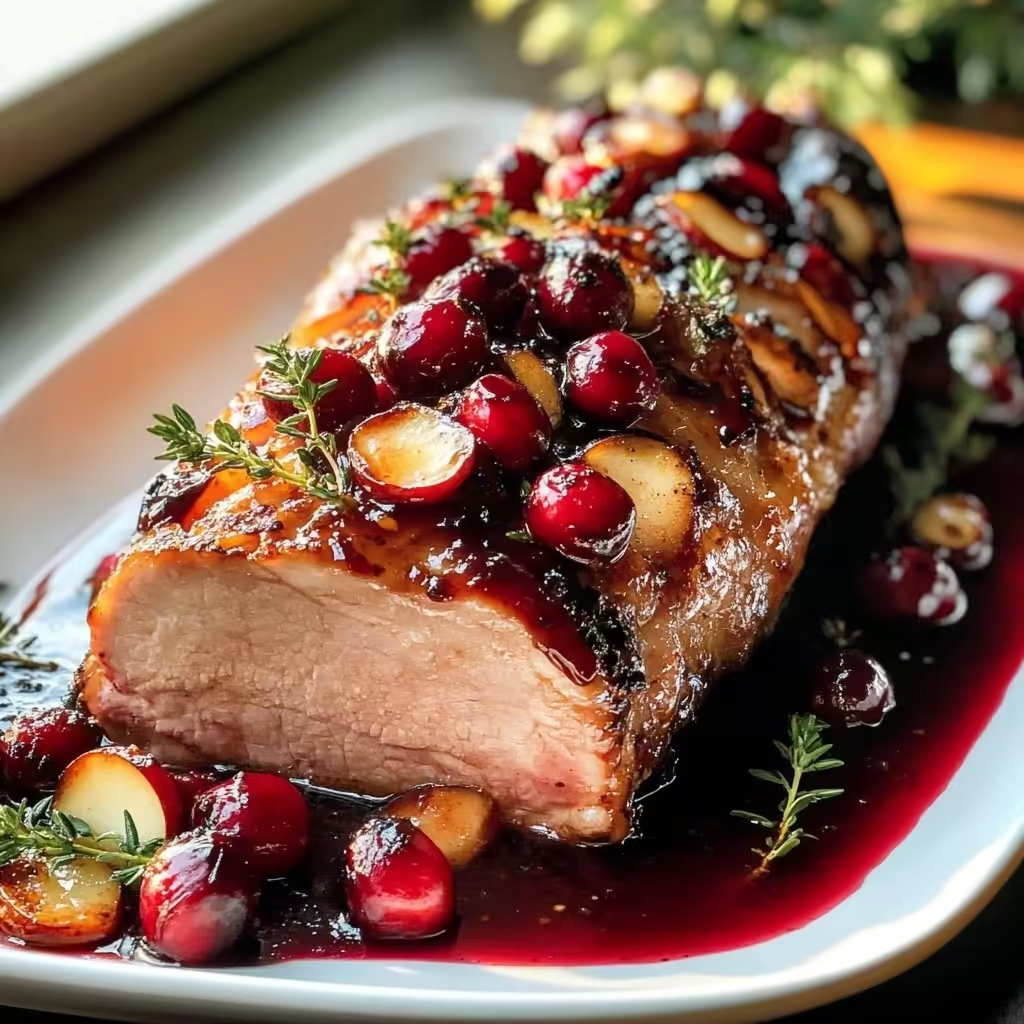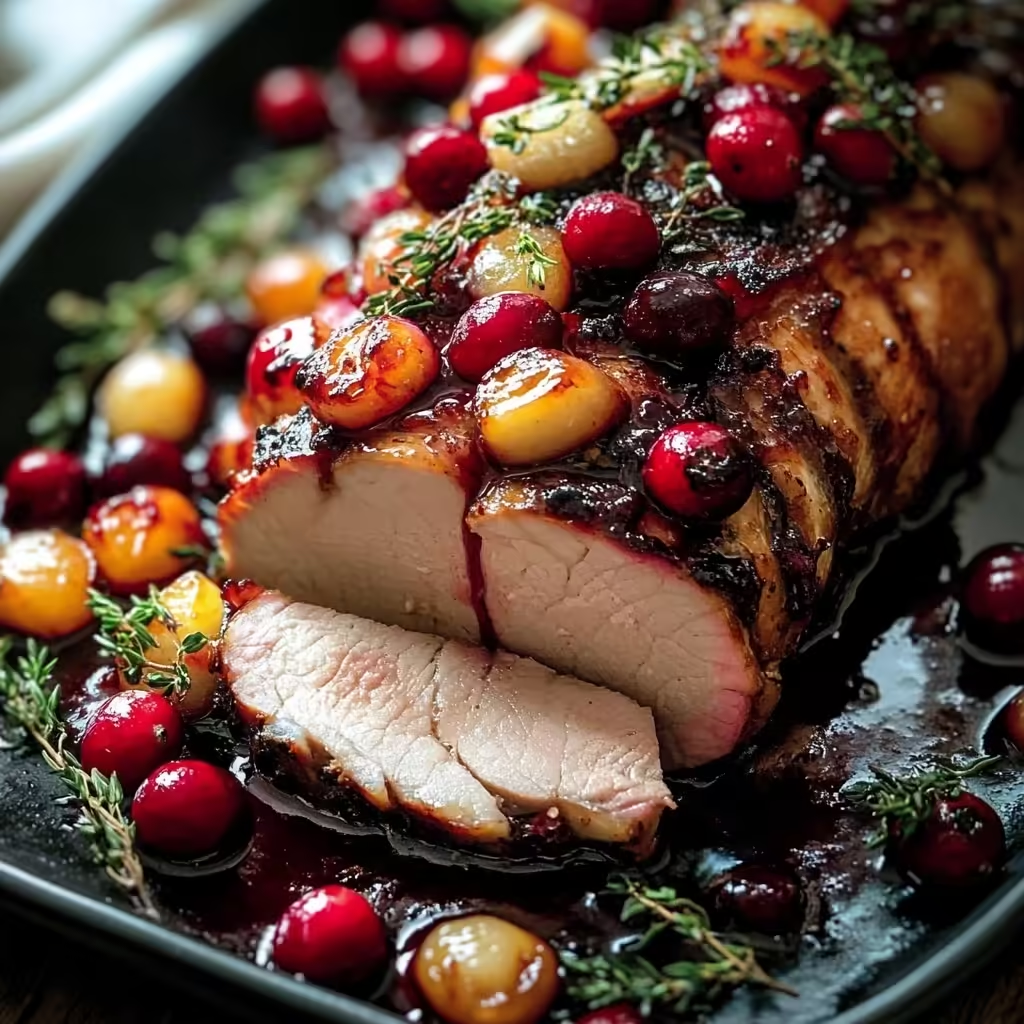Introduction to Cranberry Dijon Pork Loin Roast
Cranberry Dijon Pork Loin Roast with Apple Cider Glaze is a showstopping dish that combines the tartness of fresh cranberries, the sharpness of Dijon mustard, and the sweetness of apple cider and honey. This recipe is perfect for special occasions or holiday meals, bringing together a harmonious blend of flavors that elevate a traditional pork loin roast to something truly special. The sauce, with its combination of tangy cranberries and sweet apple cider, complements the tender and juicy pork, creating a meal that’s both comforting and elegant. This dish is ideal for fall and winter gatherings when cranberries are in season, and the warmth of the oven adds to the cozy ambiance.

Basic Recipe for Cranberry Dijon Pork Loin Roast with Apple Cider Glaze
Ingredients:
- 2-3 lb pork loin roast
- 1 cup fresh cranberries
- 1/4 cup Dijon mustard
- 1/2 cup apple cider
- 1/4 cup apple cider vinegar
- 2 tablespoons honey
- 1 tablespoon cornstarch (optional, for thickening)
- Salt and pepper to taste
Instructions:
1. Preheat the Oven:
- Start by preheating your oven to 375°F (190°C). This will ensure that the pork loin roasts evenly and develops a golden crust while staying juicy inside.
2. Season the Pork Loin:
- Season the pork loin generously with salt and pepper. Make sure to coat the entire surface of the meat to build a flavorful crust as it roasts. Place the seasoned pork loin into a roasting pan, making sure there’s enough space around it for the sauce to cook evenly.
3. Prepare the Cranberry Dijon Sauce:
- In a medium saucepan, combine the Dijon mustard, apple cider, apple cider vinegar, honey, and fresh cranberries. Cook the mixture over medium heat, stirring occasionally. As the cranberries cook, they will begin to burst, releasing their tart juices into the sauce. This process should take about 5-7 minutes. If you prefer a thicker sauce, you can mix 1 tablespoon of cornstarch with 2 tablespoons of water to create a slurry, then stir it into the sauce to thicken it.
4. Pour the Sauce Over the Pork:
- Once the sauce has come together, pour it over the pork loin in the roasting pan. The sauce should coat the pork evenly, and the cranberries will sit around the pork, caramelizing as they cook.
5. Roast the Pork:
- Place the roasting pan in the oven and roast the pork for 60-75 minutes, depending on the size of the roast. The pork is done when the internal temperature reaches 145°F (63°C). Be sure to baste the pork occasionally with the sauce from the pan to keep it moist and flavorful.
6. Rest and Serve:
- Once the pork has reached the desired temperature, remove it from the oven and let it rest for about 10 minutes before slicing. This rest period allows the juices to redistribute throughout the meat, ensuring a tender and juicy roast. Slice the pork into medallions and serve with the cranberry Dijon sauce spooned over the top.
Advanced Techniques for the Perfect Pork Loin Roast
1. Brining the Pork Loin:
- For even more tender and flavorful meat, consider brining the pork loin before cooking. To make a simple brine, dissolve 1/4 cup of salt and 1/4 cup of sugar in 4 cups of water. Submerge the pork loin in the brine and refrigerate for at least 2 hours, or overnight for best results. Brining helps to keep the meat moist during roasting and infuses it with additional flavor.
2. Searing the Pork Loin:
- To enhance the flavor and texture of the pork, you can sear it before roasting. Heat a large skillet over high heat and add a tablespoon of oil. Once the oil is hot, sear the pork loin on all sides until golden brown, about 2-3 minutes per side. This creates a caramelized crust that locks in moisture and adds depth of flavor to the roast.
3. Using a Meat Thermometer:
- The key to perfectly cooked pork loin is using a meat thermometer to monitor the internal temperature. Insert the thermometer into the thickest part of the meat to ensure accurate readings. For pork loin, the ideal temperature is 145°F (63°C), followed by a 10-minute rest period to allow the juices to settle.
4. Basting for Extra Flavor:
- Basting the pork loin with the cranberry Dijon sauce throughout the cooking process helps keep the meat moist and flavorful. Every 20-30 minutes, spoon some of the sauce from the bottom of the roasting pan over the pork to create a delicious glaze that enhances the overall taste of the dish.
5. Letting the Pork Rest:
- After the pork loin reaches the desired internal temperature, it’s essential to let it rest for 10-15 minutes before slicing. This resting period allows the meat fibers to relax, making the pork more tender and juicy. Skipping this step can result in dry, tough meat.

Maintenance Tips for Storing and Reheating
1. Storing Leftovers:
- Store any leftover pork loin in an airtight container in the refrigerator for up to 3 days. Be sure to store the sauce separately to prevent the pork from becoming too soggy. Leftover pork is delicious when reheated, but it can also be used in sandwiches, salads, or even as a topping for pizza.
2. Freezing the Pork Loin:
- If you want to freeze the leftovers, wrap the sliced pork loin tightly in plastic wrap or aluminum foil, then place it in a freezer-safe container or zip-top bag. The pork can be frozen for up to 3 months. To thaw, simply move it to the refrigerator overnight.
3. Reheating Instructions:
- To reheat the pork without drying it out, place the slices in a baking dish and cover with foil. Heat in a 350°F (175°C) oven for 10-15 minutes, or until warmed through. Alternatively, you can reheat the pork in the microwave on a lower power setting to avoid overcooking. Reheat the cranberry Dijon sauce separately and drizzle it over the pork before serving.
4. Serving Suggestions:
- Cranberry Dijon Pork Loin pairs beautifully with a variety of side dishes. For a complete holiday meal, serve it with roasted vegetables, mashed potatoes, or a simple green salad. The tangy, sweet flavors of the pork also go well with buttery dinner rolls or a creamy potato gratin.
Dietary Adaptations for Cranberry Dijon Pork Loin Roast
1. Gluten-Free Adaptation:
- This recipe is naturally gluten-free, making it a great option for those with gluten sensitivities. Just ensure that any Dijon mustard and apple cider vinegar you use are certified gluten-free to avoid any hidden gluten sources.
2. Dairy-Free Version:
- This recipe is already dairy-free, so no modifications are needed if you are avoiding dairy. The butter typically used for basting can be replaced with olive oil for added flavor and moisture, though it’s not essential in this recipe.
3. Paleo-Friendly Version:
- To make this dish paleo-friendly, swap the honey for maple syrup or another natural sweetener, and make sure to use a high-quality, organic Dijon mustard with no added sugars or preservatives. Additionally, ensure that the apple cider and apple cider vinegar are free from any added sugars or artificial ingredients.
4. Low-Sugar Option:
- If you’re looking to reduce the sugar content, you can reduce or omit the honey in the sauce. The natural sweetness from the cranberries and apple cider will still provide a flavorful sauce. For a completely sugar-free version, you can use a sugar substitute like erythritol or monk fruit in place of honey.
5. Keto-Friendly Version:
- For a keto-friendly adaptation, use a sugar-free sweetener like monk fruit or erythritol instead of honey. Ensure that the Dijon mustard and apple cider vinegar you use contain no added sugars, and substitute apple cider with a lower-carb option like unsweetened cranberry juice diluted with water.

Frequently Asked Questions (FAQs)
Q: Can I use frozen cranberries instead of fresh?
- Yes, frozen cranberries work just as well as fresh ones in this recipe. Simply add the frozen cranberries directly to the sauce without thawing them first. They will burst and release their tart juices as they cook, just like fresh cranberries.
Q: Can I cook the pork loin in a slow cooker instead of the oven?
- Absolutely! To make this recipe in a slow cooker, follow the same instructions for preparing the sauce and seasoning the pork. Place the pork loin in the slow cooker, pour the sauce over it, and cook on low for 6-8 hours or on high for 3-4 hours, until the pork reaches an internal temperature of 145°F (63°C). Baste occasionally if possible.
Q: How do I prevent the pork loin from drying out?
- To prevent dryness, monitor the internal temperature of the pork closely with a meat thermometer. Pull the pork from the oven once it reaches 145°F (63°C) and allow it to rest before slicing. Overcooking is the most common cause of dry pork. Basting the pork with sauce during cooking also helps retain moisture.
Q: Can I use a different cut of pork for this recipe?
- Yes, you can use other cuts like pork tenderloin or pork shoulder. Pork tenderloin will cook faster, so adjust the cooking time accordingly. Pork shoulder will require a longer cooking time but will yield a more tender, pulled-pork style result.
Q: Can I make this recipe ahead of time?
- Yes, this pork loin roast can be made ahead of time. Simply roast the pork as instructed, then allow it to cool completely. Store the pork and sauce separately in the refrigerator. Reheat before serving, and slice the pork just before serving to maintain its moisture.
Conclusion
Cranberry Dijon Pork Loin Roast with Apple Cider Glaze is a versatile and flavorful dish that’s perfect for both casual family dinners and special holiday gatherings. With its vibrant cranberry sauce, tangy mustard, and the richness of apple cider, this roast offers a beautiful balance of flavors that will impress your guests. Whether you’re following the classic recipe or making dietary adjustments, this roast is a must-try for anyone looking to elevate their pork dinner.

